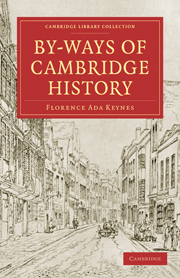Book contents
- Frontmatter
- PREFACE
- Contents
- ILLUSTRATIONS
- Introductory
- Chap. I The Guildhall and the Market Place
- Chap. II The Office of High Steward of the Borough of Cambridge
- Chap. III Cambridge Waits and Orlando Gibbons
- Chap. IV Barnwell Priory and the Old Abbey House
- Chap. V Why Oxford comes First. A Problem in Precedence
- Chap. VI Damaris Cudworth.—A Cambridge Woman of the Seventeenth Century
- Chap. VII A Town Plan for Cambridge in the Eighteenth Century
- Chap. VIII Mendicity House. Sidelights on Social Conditions in Cambridge in the Nineteenth Century
- Appendix: ‘Cambridge’ as a place-name
- Index
- Plate section
Chap. IV - Barnwell Priory and the Old Abbey House
Published online by Cambridge University Press: 07 September 2010
- Frontmatter
- PREFACE
- Contents
- ILLUSTRATIONS
- Introductory
- Chap. I The Guildhall and the Market Place
- Chap. II The Office of High Steward of the Borough of Cambridge
- Chap. III Cambridge Waits and Orlando Gibbons
- Chap. IV Barnwell Priory and the Old Abbey House
- Chap. V Why Oxford comes First. A Problem in Precedence
- Chap. VI Damaris Cudworth.—A Cambridge Woman of the Seventeenth Century
- Chap. VII A Town Plan for Cambridge in the Eighteenth Century
- Chap. VIII Mendicity House. Sidelights on Social Conditions in Cambridge in the Nineteenth Century
- Appendix: ‘Cambridge’ as a place-name
- Index
- Plate section
Summary
THE early history of the Augustinian Priory at Barnwell has fortunately been recorded in a manuscript put together from older documents probably at the end of the thirteenth century, or rather later, as it ends abruptly about 1297. It is usually called the Barnwell Cartulary, but is best described by the author's own title, Liber Memorandorutn Ecclesiae de Bernewelle, that is, ‘The Book of those things relating to the church of Barnwell which are worthy of recollection’.
This valuable document is now in the Harleian Collection in the British Museum—a document closely connected with Cambridge, not only as having been drawn up in the Priory and in all probability having remained there until the dissolution of the monastery, but also in its later history.
Edward Harley, second Earl of Oxford, after whom the collection is named, and from whose widow it was acquired for the nation, was High Steward of the Borough of Cambridge in the first half of the eighteenth century (1727–41). He was also for thirty years owner of the Wimpole estate in the County of Cambridge until a few months before his death when, as the result of financial difficulties, he had to part with it to Lord Chancellor Hardwicke. He had spent so much on enlarging the Hall, on his high standard of living and on his miscellaneous collections that he had run through not only his own fortune but the main part of that of his wife who had brought him Wimpole and other property as the heiress of her father John Holies, Duke of Newcastle.
- Type
- Chapter
- Information
- By-Ways of Cambridge History , pp. 81 - 108Publisher: Cambridge University PressPrint publication year: 2009First published in: 1947

